John Fitzgerald Kennedy
John F. Kennedy
Military service (1941–45)

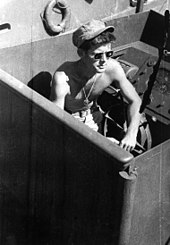
Congressional career
House of Representatives (1946–52)
Senate (1952–60)

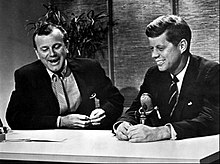
1960 presidential election
 We choose to go to the Moon in this decade and do the other things, not because they are easy, but because they are hard; because that goal will serve to organize and measure the best of our energies and skills; because that challenge is one that we are willing to accept, one we are unwilling to postpone, and one which we intend to win ...
We choose to go to the Moon in this decade and do the other things, not because they are easy, but because they are hard; because that goal will serve to organize and measure the best of our energies and skills; because that challenge is one that we are willing to accept, one we are unwilling to postpone, and one which we intend to win ...It is for these reasons that I regard the decision last year to shift our efforts in space from low to high gear as among the most important decisions that will be made during my incumbency in the office of the Presidency. - JFK, 1962
Foreign policy
 Persian Shah Mohammad Reza Pahlavi, Kennedy, and U.S. Defense Secretary Robert McNamara in the White House Cabinet Room on April 13, 1962.
Persian Shah Mohammad Reza Pahlavi, Kennedy, and U.S. Defense Secretary Robert McNamara in the White House Cabinet Room on April 13, 1962.Cuba and the Bay of Pigs Invasion
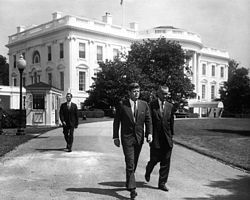 Pres. Kennedy and Vice Pres. Johnson.
Pres. Kennedy and Vice Pres. Johnson.Cuban Missile Crisis
 Meeting Nikita Khrushchev in 1961.
Meeting Nikita Khrushchev in 1961. Latin America and communism
Peace Corps
John F. Kennedy's announcement of the establishment of the Peace Corps
| |
| Problems playing this file? See media help. | |
Southeast Asia
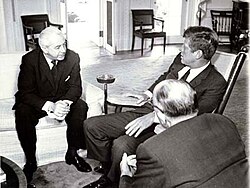 Kennedy with future Australian Prime Minister Harold Holt in the Oval Office in 1963.
Kennedy with future Australian Prime Minister Harold Holt in the Oval Office in 1963.American University speech
 Kennedy delivers thecommencement speech atAmerican University, June 10, 1963
Kennedy delivers thecommencement speech atAmerican University, June 10, 1963 West Berlin speech
 Kennedy delivering his speech in West Berlin
Kennedy delivering his speech in West Berlin  |
Ich bin ein Berliner speech from the Rathaus Schöneberg by John F. Kennedy, June 26, 1963 (duration 9:01)
|
Israel
Iraq
Ireland
 John F. Kennedy visiting the John Barry Memorial at Crescent Quay in Wexford, Ireland.
John F. Kennedy visiting the John Barry Memorial at Crescent Quay in Wexford, Ireland. President Kennedy in motorcade in Patrick Street, Cork, in Ireland on June 28, 1963.
President Kennedy in motorcade in Patrick Street, Cork, in Ireland on June 28, 1963. Nuclear Test Ban Treaty
Domestic policy
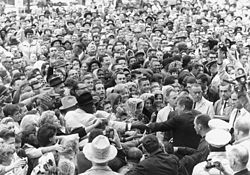 President Kennedy in Fort Worth, Texas on November 22, 1963.
President Kennedy in Fort Worth, Texas on November 22, 1963. Economy
Federal and military death penalty
Civil rights
 President Kennedy's Civil Rights Address, June 11, 1963.
President Kennedy's Civil Rights Address, June 11, 1963.  Kennedy with leaders of the March on Washington, August 28, 1963.
Kennedy with leaders of the March on Washington, August 28, 1963. Civil liberties
Immigration
Native American relations
Space policy
 Kennedy proposing a program to land men on the Moon to Congress in May 1961.
Kennedy proposing a program to land men on the Moon to Congress in May 1961. Assassination
 John, Jackie, and the Connallys in the presidential limousine seconds before the assassination.
John, Jackie, and the Connallys in the presidential limousine seconds before the assassination. Funeral
 President Kennedy's family leaving hisfuneral at the U.S. Capitol Building
President Kennedy's family leaving hisfuneral at the U.S. Capitol Building Administration, Cabinet, and judicial appointments 1961–63
| The Kennedy Cabinet | ||
|---|---|---|
| Office | Name | Term |
| President | John F. Kennedy | 1961–1963 |
| Vice President | Lyndon B. Johnson | 1961–1963 |
| Secretary of State | Dean Rusk | 1961–1963 |
| Secretary of Treasury | C. Douglas Dillon | 1961–1963 |
| Secretary of Defense | Robert McNamara | 1961–1963 |
| Attorney General | Robert F. Kennedy | 1961–1963 |
| Postmaster General | J. Edward Day | 1961–1963 |
| John A. Gronouski | 1963 | |
| Secretary of the Interior | Stewart Udall | 1961–1963 |
| Secretary of Agriculture | Orville Freeman | 1961–1963 |
| Secretary of Commerce | Luther H. Hodges | 1961–1963 |
| Secretary of Labor | Arthur Goldberg | 1961–1962 |
| W. Willard Wirtz | 1962–1963 | |
| Secretary of Health, Education, and Welfare | Abraham A. Ribicoff | 1961–1962 |
| Anthony J. Celebrezze | 1962–1963 | |
Judicial appointments
Supreme Court
- Byron White – 1962
- Arthur Goldberg – 1962
Other courts
Image, social life and family
 The Kennedy family in Hyannis Port, Massachusetts, in 1963.
The Kennedy family in Hyannis Port, Massachusetts, in 1963. "Camelot Era"
 Jacqueline Kennedy in Fort Worth, Texas, on November 22, 1963
Jacqueline Kennedy in Fort Worth, Texas, on November 22, 1963  The Kennedy brothers: Attorney GeneralRobert F. Kennedy, Senator Ted Kennedy, and President John F. Kennedy in 1963
The Kennedy brothers: Attorney GeneralRobert F. Kennedy, Senator Ted Kennedy, and President John F. Kennedy in 1963 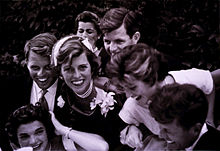 Jack and Jackie Kennedy on their wedding day, surrounded by relatives
Jack and Jackie Kennedy on their wedding day, surrounded by relatives 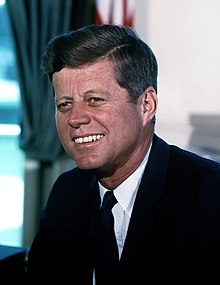

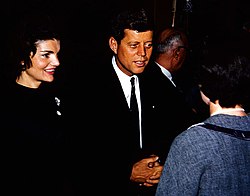






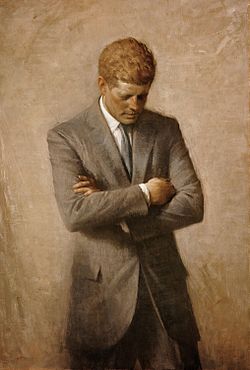
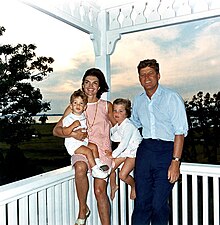
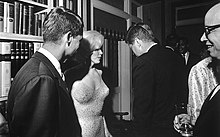









































































No comments:
Post a Comment